1 SolrJ是什么
说明: SolrJ是访问Solr服务的Java客户端程序, 提供了索引和搜索的请求方法.
SolrJ通常嵌入在业务系统中, 通过SolrJ的API接口操作Solr服务, 流程如下图:

2 SolrJ对索引的CRUD操作
使用SolrJ访问Solr服务, 完成索引的增、删、改、查操作.
2.1 创建Maven工程(打包方式选择为jar)
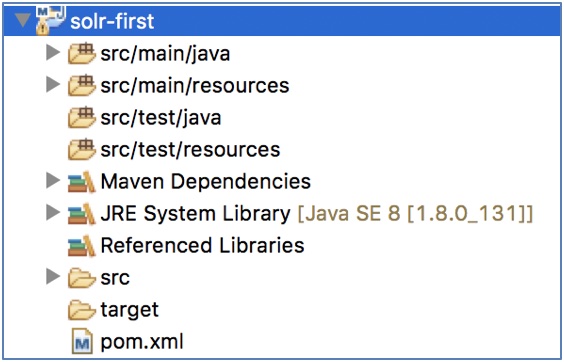
2.2 配置pom.xml文件, 加入SolrJ的依赖
<project xmlns="http://maven.apache.org/POM/4.0.0" xmlns:xsi="http://www.w3.org/2001/XMLSchema-instance"
xsi:schemaLocation="http://maven.apache.org/POM/4.0.0 http://maven.apache.org/xsd/maven-4.0.0.xsd">
<modelVersion>4.0.0</modelVersion>
<packaging>jar</packaging>
<properties>
<project.build.sourceEncoding>UTF-8</project.build.sourceEncoding>
<!-- solrj版本 -->
<solrj.version>4.10.4</solrj.version>
<!-- log4j日志版本 -->
<slf4j.version>1.7.7</slf4j.version>
<log4j.version>1.2.17</log4j.version>
<!-- jcl版本 -->
<jcl.version>1.7.6</jcl.version>
<junit.version>4.12</junit.version>
</properties>
<dependencies>
<!-- solrj依赖 -->
<dependency>
<groupId>org.apache.solr</groupId>
<artifactId>solr-solrj</artifactId>
<version>${solrj.version}</version>
</dependency>
<!-- log4j日志包 -->
<dependency>
<groupId>log4j</groupId>
<artifactId>log4j</artifactId>
<version>${log4j.version}</version>
</dependency>
<dependency>
<groupId>org.slf4j</groupId>
<artifactId>slf4j-api</artifactId>
<version>${slf4j.version}</version>
</dependency>
<dependency>
<groupId>org.slf4j</groupId>
<artifactId>slf4j-log4j12</artifactId>
<version>${slf4j.version}</version>
</dependency>
<dependency>
<groupId>org.slf4j</groupId>
<artifactId>jcl-over-slf4j</artifactId>
<version>${jcl.version}</version>
</dependency>
<dependency>
<groupId>org.slf4j</groupId>
<artifactId>jul-to-slf4j</artifactId>
<version>${jcl.version}</version>
</dependency>
<dependency>
<groupId>junit</groupId>
<artifactId>junit</artifactId>
<version>${junit.version}</version>
<scope>test</scope>
</dependency>
</dependencies>
</project>
2.3 添加和修改索引
说明: Solr是根据id域(唯一约束)执行索引的添加(或更新)的:
先根据id域执行查询, 查询到执行更新; 查询不到则执行添加.
步骤:
(1) 创建HttpSolrServer对象, 连接Solr服务;
(2) 创建文档对象(SolrInuptDocument);
(3) 使用HttpSolrServer对象, 执行添加(或更新);
(4) 提交.
/**
* 添加与修改索引
*/
@Test
public void testSaveAndUpdateIndex() throws Exception {
// 1. 创建HttpSolrServer对象, 连接Solr服务
// 参数baseURL: 指定Solr的服务地址
HttpSolrServer server = new HttpSolrServer("http://127.0.0.1:7070/solr");
// 2. 创建文档对象(SolrInputDocument)
SolrInputDocument document = new SolrInputDocument();
// 在Solr中, id域是必需的
document.addField("id", "9527");
// 先设置如下值:
// document.addField("name", "solr solrj");
// 再次设置, 测试更新索引 -- 如果存在则更新, 不存在则添加
document.addField("name", "solr123 solrj");
// 3. 使用HttpSolrServer对象, 执行添加(或更新)
server.add(document);
// 4. 提交更新
server.commit();
}
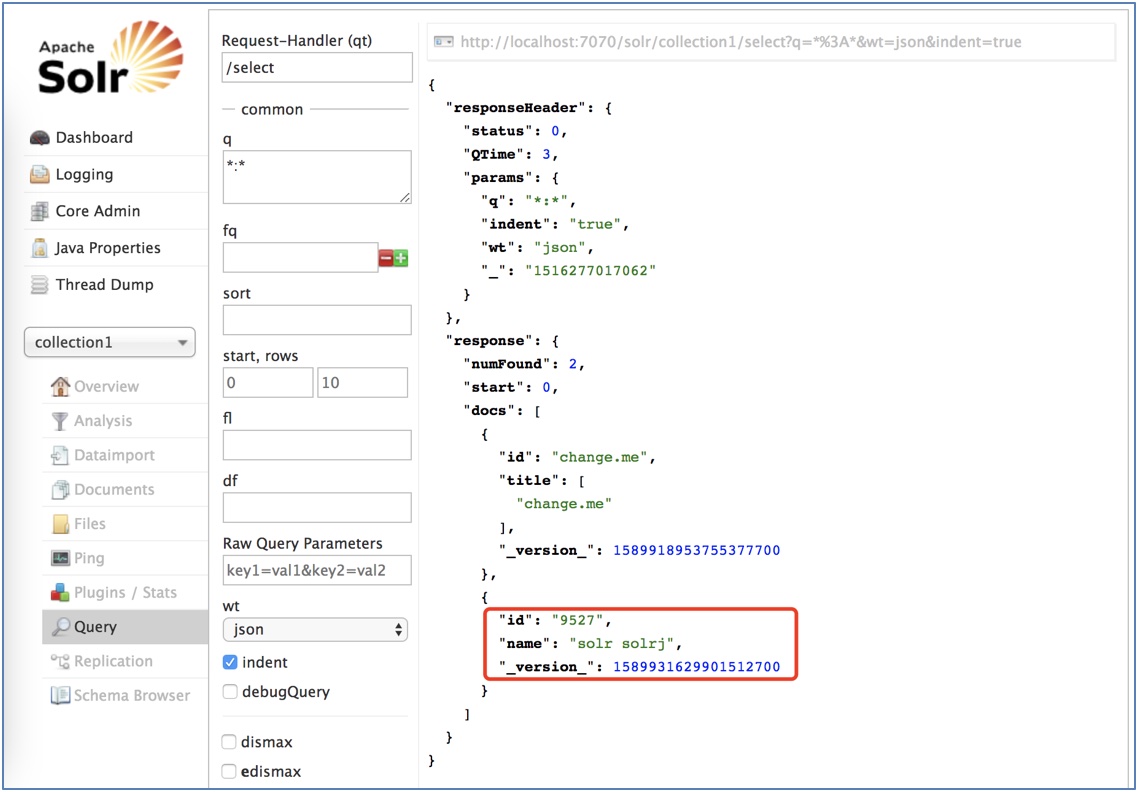
2.4 删除索引
(1) 根据id删除索引, 步骤为:
① 创建HttpSolrServer对象, 连接Solr服务;
② 使用HttpSolrServer对象, 执行删除;
③ 提交.
/**
* 根据id删除索引
*/
@Test
public void testDeleteIndexById() throws SolrServerException, IOException {
// 1. 创建HttpSolrServer对象, 连接Solr服务
// 参数baseURL: 指定Solr的服务地址
HttpSolrServer server = new HttpSolrServer("http://127.0.0.1:7070/solr");
// 2. 使用HttpSolrServer对象, 执行删除
server.deleteById("9527");
// 3. 提交
server.commit();
}
(2) 根据条件删除索引, 步骤为:
① 创建HttpSolrServer对象, 连接solr服务;
② 使用HttpSolrServer对象, 执行删除;
③ 提交.
/**
* 根据条件删除索引
*/
@Test
public void testDeleteIndexByQuery() throws Exception {
// 1. 创建HttpSolrServer对象, 连接Solr服务
HttpSolrServer server = new HttpSolrServer("http://127.0.0.1:7070/solr");
// 2. 使用HttpSolrServer对象, 执行删除
server.deleteByQuery("name: solr");
// 3. 提交更新
server.commit();
}
2.5 查询索引
查询步骤:
(1) 创建HttpSolrServer对象, 连接Solr服务;
(2) 创建查询对象(SolrQuery);
(3) 使用HttpSolrServer对象, 执行查询, 返回查询响应对象QueryResponse;
(4) 使用QueryResponse对象, 获取查询的结果集SolrDocumentList;
(5) 处理结果集.
/**
* 查询索引
*/
@Test
public void testQueryIndex() throws Exception {
// 1. 创建HttpSolrServer对象, 连接Solr服务
HttpSolrServer server = new HttpSolrServer("http://127.0.0.1:7070/solr");
// 2. 创建查询对象(Query)
// : 表示查询所有
SolrQuery query = new SolrQuery(":");
// 3.使用HttpSolrServer对象, 执行查询, 返回查询响应对象QueryResponse
QueryResponse queryResponse = server.query(query);
// 4.使用QueryResponse对象, 获取查询的结果集SolrDocumentList
SolrDocumentList results = queryResponse.getResults();
// 5.处理结果集
// 打印查询到的结果数量
System.out.println("结果数量: " + results.getNumFound());
for (SolrDocument doc : results) {
System.out.println("= = = = = = = = = = = = = = = = = = =");
// 打印id域和name域
System.out.println("id: " + doc.get("id"));
System.out.println("name: " + doc.get("name"));
}
}
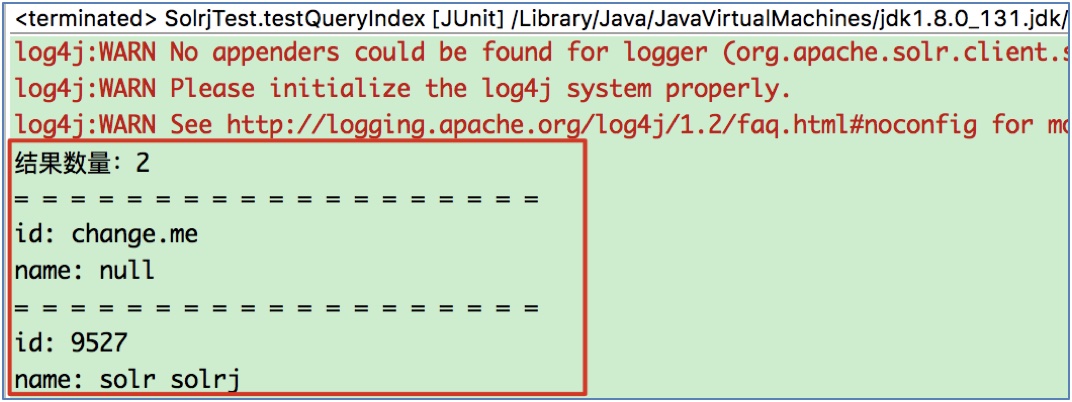
3 SolrJ的查询方案
3.1 实现步骤
(1) 创建HttpSolrServer对象, 连接Solr服务;
(2) 创建查询对象(SolrQuery), 设置查询条件;
(3) 使用HttpSolrServer对象, 执行查询, 返回查询响应对象(QueryResponse);
(4) 使用QueryResponse对象, 获取查询数据;
(5) 处理结果集.
3.2 示例代码
/**
* SolrJ高级查询
*/
@Test
public void queryIndexSenior() throws Exception {
// 1. 创建HttpSolrServer对象, 连接Solr服务
// 参数baseURL:指定Solr的服务地址
HttpSolrServer solrServer = new HttpSolrServer("http://127.0.0.1:7070/solr/collection1");
// 2. 创建查询对象(SolrQuery), 设置查询条件
SolrQuery solrQuery = new SolrQuery();
// 2.1 设置查询表达式
solrQuery.setQuery("花儿朵朵");
// 2.2 设置过滤条件
solrQuery.setFilterQueries("product_price:[* TO 20]");
// 2.3 设置排序sort
solrQuery.setSort("product_price", ORDER.desc);
// 2.4 设置分页: start, rows
solrQuery.setStart(0);
solrQuery.setRows(10);
// 2.5 设置显示的域列表
solrQuery.setFields("id", "product_name", "product_price", "product_catalog_name");
// 2.6 设置默认的搜索域
solrQuery.set("df", "product_name");
// 2.7 设置响应格式
solrQuery.set("wt", "json");
// 2.8 设置高亮显示
solrQuery.setHighlight(true); // 开启高亮显示
// 或者: solrQuery.setParam("hl", "true");
solrQuery.addHighlightField("product_name"); // 添加高亮显示的域
solrQuery.setHighlightSimplePre("<font color='red'>"); // 设置高亮显示的HTML标签的前缀
solrQuery.setHighlightSimplePost("<font>"); // 设置高亮显示的HTML标签的后缀
// 2.9 设置分片统计facet
solrQuery.setFacet(true); // 开启分片统计
solrQuery.addFacetField("product_catalog_name"); // 添加分片统计的域
// 3. 使用HttpSolrServer对象, 执行查询, 返回查询相应对象
QueryResponse queryResponse = solrServer.query(solrQuery);
/* 处理结果集
NamedList list = (NamedList) queryResponse.getResponse().get("highlighting");
for (int i = 0; i < list.size(); i++) {
System.out.println("id=" + list.getName(i) + "高亮字段: " + list.getVal(i));
}
*/
// 4. 使用QueryResponse对象, 获取查询数据
// 4.1 获取查询结果集
SolrDocumentList results = queryResponse.getResults();
// 4.2 获取高亮显示数据
// 第一个Map的key是文档的id, 第二个Map的key是高亮显示的字段名, 第二个Map中的value是处理过的高亮显示结果集, 类型为List<String>
Map<String, Map<String, List<String>>> hlMap = queryResponse.getHighlighting();
// 4.3 获取分片统计数据
List<FacetField> facetFields = queryResponse.getFacetFields();
// 6. 处理结果集
System.out.println("结果数量:" + results.getNumFound());
for (SolrDocument doc : results) {
System.out.println("= = = = = = = = = = = = = = = = = = =");
// id, product_name, product_price, product_catalog_name
// 获取商品id
String pid = doc.get("id").toString();
// 获取商品名称: 先从高亮显示结果中获取, 若没有获取到, 再从doc中获取
String pname = "";
List<String> list = hlMap.get(pid).get("product_name");
if (null != list && list.size() > 0) {
pname = list.get(0);
} else {
pname = doc.get("product_name").toString();
}
// 获取商品价格
String pprice = doc.get("product_price").toString();
// 获取商品的分类名称
String pcatalogName = doc.get("product_catalog_name").toString();
// 输出结果
System.out.println("商品id: " + pid);
System.out.println("商品名称: " + pname);
System.out.println("商品价格: " + pprice);
System.out.println("商品分类名称: " + pcatalogName);
}
}
3.3 代码搜索结果
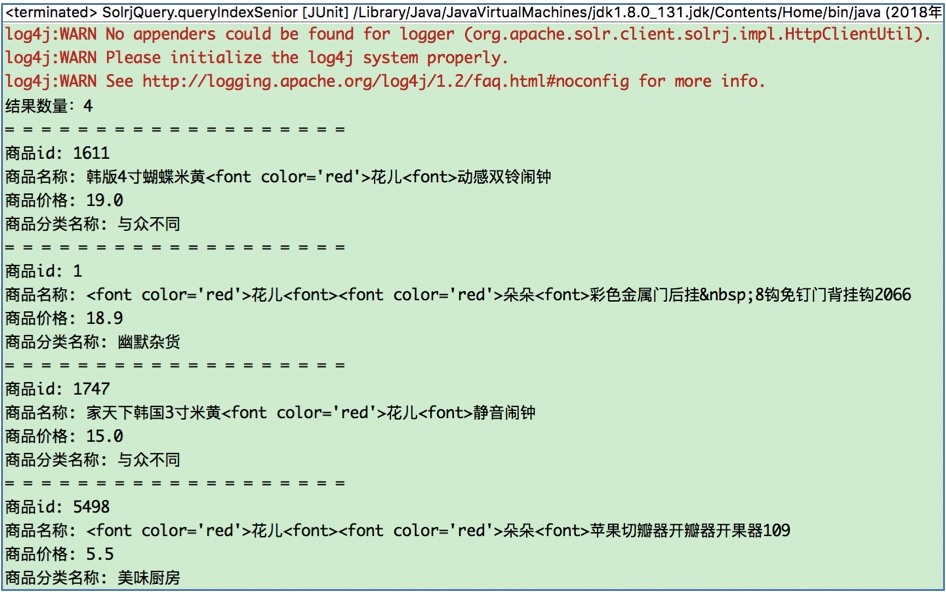
3.4 查看分片统计数据
// 5. 处理分片统计数据(如有)
System.out.println("分片统计数据 = = = = = = = = = = = Begin");
for (FacetField field : facetFields) {
System.out.println("统计域名称: " + field.getName() + " , 统计到的组数量: " + field.getValueCount());
// 查看各个组的数量
List<Count> values = field.getValues();
for (Count count : values) {
System.out.println("组名称: " + count.getName() + " , 该组的数量: " + count.getCount());
}
}
System.out.println("分片统计数据 = = = = = = = = = = = End");
3.5 分片统计数据结果
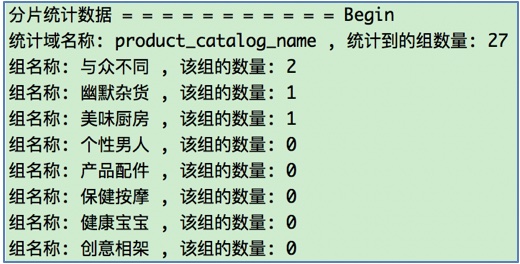
版权声明
作者: 马瘦风
出处: 博客园 马瘦风的博客
您的支持是对博主的极大鼓励, 感谢您的阅读.
本文版权归博主所有, 欢迎转载, 但请保留此段声明, 并在文章页面明显位置给出原文链接, 否则博主保留追究相关人员法律责任的权利.